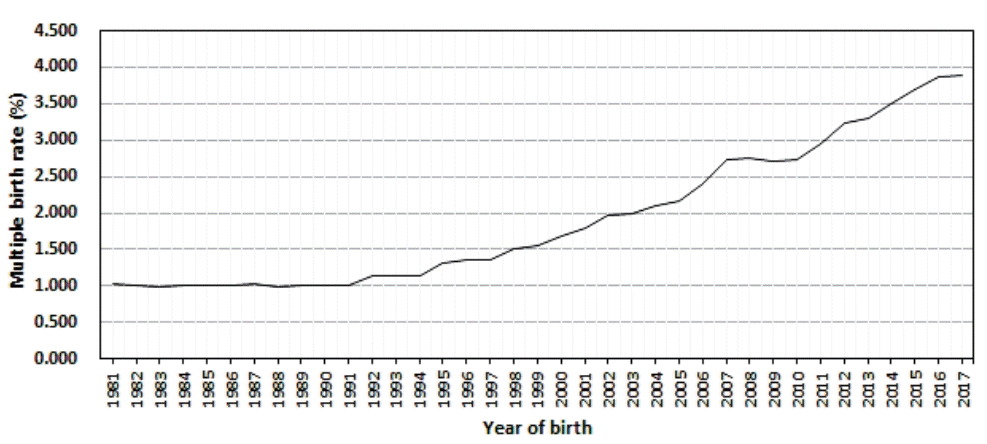Blondel B., Kaminski M. Trends in the occurrence, determinants, and consequences of multiple births. Semin Perinatol. 2002. 26:239–49.

Chambers GM., Hoang VP., Lee E., Hansen M., Sullivan EA., Bower C, et al. Hospital costs of multiple-birth and singleton-birth children during the first 5 years of life and the role of assisted eproductive technology. JAMA Pediatr. 2014. 168:1045–53.
Chambers GM., Wang YA., Chapman MG., Hoang VP., Sullivan EA., Abdalla HI, et al. What can we learn from a decade of promoting safe embryo transfer practices? A comparative analysis of policies and outcomes in the UK and Australia, 2001-2010. Hum Reprod. 2013. 28:1679–86.

Chandra A., Stephen EH. Infertility service use among U.S. women: 1995 and 2002. Fertil Steril. 2010. 93:725–36.

Collins J. Global epidemiology of multiple birth. Reprod Biomed Online. 2007. 15 Suppl 3:45–52.

Committee for Assisted Reproductive Technology; Korean Society for Assisted Reproduction., Lee GH., Song HJ., Lee KS, et al. Current status of assisted reproductive technology in Korea, 2011. Clin Exp Reprod Med. 2016. 43:38–43.

Delnord M., Blondel B., Zeitlin J. What contributes to disparities in the preterm birth rate in European countries? Curr Opin Obstet Gynecol. 2015. 27:133–42.

Eriksson AW., Fellman J. Temporal trends in the rates of multiple maternities in England and Wales. Twin Res Hum Genet. 2007. 10:626–32.

Hamilton BE., Martin JA., Osterman MJ., Curtin SC., Matthews TJ. Births: final data for 2014. Natl Vital Stat Rep. 2015. 64:1–64.
Hur YM., Kwon JS. Changes in twinning rates in South Korea: 1981-2002. Twin Res Hum Genet. 2005. 8:76–9.

Hwang NM., Chae SM., Chang IS. Analysis and evaluation of the results of national supporting program for infertile couples in 2014. Sejong (Korea): Korea Institute for Health and Social Affairs;2015. p. 19–39.
Hwang NM., Chang IS., Park SM., Chae SM. Analysis and evaluation of the results of national supporting program for infertile couples in 2012. Sejong (Korea): Korea Institute for Health and Social Affairs;2013.
Hwang NM., Lee SH., Chang IS. Analysis and evaluation of the results of national supporting program for infertile couples in 2016. Sejong (Korea): Korea Institute for Health and Social Affairs;2017. p. 4–26.
Ko HS., Wie JH., Choi SK., Park IY., Park YG., Shin JC. Multiple birth rates of Korea and fetal/neonatal/infant mortality in multiple gestation. PLoS One. 2018. 13:e0202318.

Luke B., Martin JA. The rise in multiple births in the United States: who, what, when, where, and why. Clin Obstet Gynecol. 2004. 47:118–33.

Martin JA., Hamilton BE., Osterman MJ. Three decades of twin births in the United States, 1980-2009. NCHS Data Brief. 2012. 80:1–8.
Martin JA., Hamilton BE., Ventura SJ., Osterman MJ., Kirmeyer S., Mathews TJ, et al. Births: final data for 2009. Natl Vital Stat Rep. 2011. 60:1–70.
Martin JA., Park MM. Trends in twin and triplet births: 1980-97. Natl Vital Stat Rep. 1999. 47:1–16.
Ministry of Health and Welfare. National supporting program for infertile couples. Guideline for 2016 Maternal and Childe Health Services. Sejong (Korea): Korea Ministry of Health and Welfare;2016. p. 135–61.
Murray SR., Norman JE. Multiple pregnancies following assisted reproductive technologies--a happy consequence or double trouble? Semin Fetal Neonatal Med. 2014. 19:222–7.
Park SH., Kim JS., Lim DO. Adverse child's birth outcomes and maternal age at birth; 1997-98, 2014-15 birth certificate data of Korea. J Health Info Stat. 2017. 42:294–300.

Park SH., Kim TJ., Moon SY., Kim SH. Study on Trends of Multiple Birth in Korea: 1982-1998. Korean J Perinatol. 2001. 12:449–52.
Park SH., Lim DO. Contribution of maternal age distribution to incidence of multiple birth rate; 1997-99 and 2011-13. J Reprod Med Popul. 2015. 28:96–102.
Reynolds MA., Schieve LA., Martin JA., Jeng G., Macaluso M. Trends in multiple births conceived using assisted reproductive technology, United States, 1997-2000. Pediatrics. 2003. 111(5 Pt 2):1159–62.
Scholten I., Chambers GM., van Loendersloot L., van der Veen F., Repping S., Gianotten J, et al. Impact of assisted reproductive technology on the incidence of multiplegestation infants: a population perspective. Fertil Steril. 2015. 103:179–83.
Tandberg A., Bjørge T., Børdahl PE., Skjaerven R. Increasing twinning rates in Norway, 1967-2004: the influence of maternal age and assisted reproductive technology (ART). Acta Obstet Gynecol Scand. 2007. 86:833–9.

Wright VC., Chang J., Jeng G., Chen M; Macaluso M; Centers for Disease Control and Prevention. Assisted reproductive technology surveillance - United States, 2004. MMWR Surveill Summ. 2007. 56:1–22.





 PDF
PDF Citation
Citation Print
Print



 XML Download
XML Download